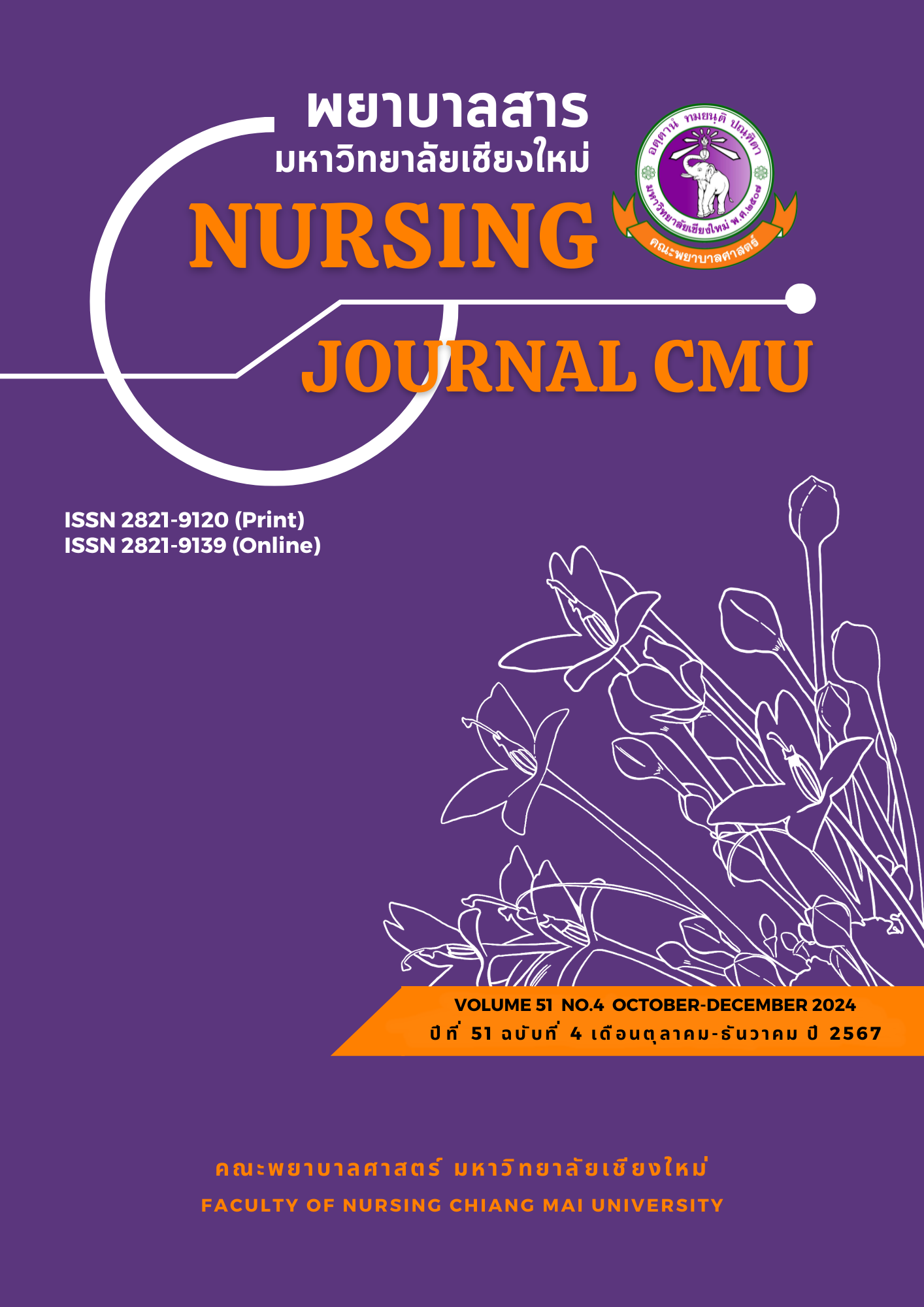Predicting Factors of Perceived 21st Century Competency Among Nursing Students
Keywords:
Perceived 21st Century Competency, Nursing student, Predicting factorsAbstract
21st century competency refers to important characteristics and skills that enable and improve learning of nursing students which leads to learning outcomes development according to the National Higher Education Qualifications Framework. This competence is composed of five aspects: 1) capacity to communicate, 2) capacity to think, 3) capacity to perform problem-solving, 4) capacity for applying life skills, and 5) technological compe- tency. This predictive correlational research aimed to investigate the predictive ability of selected factors on nursing students’ competency. The participants consisted of 144 nursing students who were currently studying at the Buri Ram Province private university in their 1st to 4th years. Stratified random sampling was used to recruit samples. The instruments consisted of 1) a demographic data record form (age, gender, grade point average, family monthly income, and monthly income from family), 2) the SPST 20 stress questionnaire, and 3) the nursing students’ perceived 21st century competency questionnaire. Data was analyzed using descriptive statistics, Pearson correlation coefficient, and stepwise multiple regression equations.
The results revealed that participants’ overall perceived 21st century competency was at a high level (M = 1.35, SD = 0.39). Students’ college year and their monthly income from family were statistically significantly correlated with their perceived 21st century compe- tency (r = -.016, p < .01; and r = .106, p < .01, respectively). Nevertheless, college year (β = -.136, p < .001) and monthly income from family (β = .031, p < .001) statistically significantly predicted perceived 21st century competency at 6.6% (R2 = .066, F (df1= 2, df2 = 141) = 1.291, p < .001).
The results of this study can be used as basic information to enhance the 21st century competency of nursing students.
References
Bellanca, J. (2011). 21st Century skills-rethinking how student learn. In V. Wongkijrungruang & A. Chittaroung (Eds.), Translator. Open worlds Publishing.
Benner, P. (1984). From novice to expert: Excellence and power in clinical nursing practice. Addison-Wesley.
Chunchomgul, C., & Wangsukpisan, A. (2020). Factors related to the performance of clinical practice for patient safety among nursing students. The Journal of Faculty of Nursing Burapha University, 28(4), 100-113. (in Thai)
Department of Mental Health, Ministry of Public Health. (2007). Stress assessment form, department of mental health STSP 20. Department of Mental Health. (in Thai)
Facione, P. A. (1990). Critical thinking: A statement of expert consensus for purposes of educational assessment and instruction-The Delphi report. Academic Press.
Hirunchunha, S., Bungkong, S., Phumdung, S., Boonyoung, N., & Sangchan, H. (2021). Lifelong learning competency of nursing students, supporting and obstacle to factors related to lifelong learning competency development. Songklanagarind Journal of Nursing, 41(4), 38-49. (in Thai)
Khemapech, S. (2016). The factors associated with motive achievement in police nursing students. Journal of the Police Nurses, 8(1), 116-124. (in Thai)
Khoyun, S., Sukontawat, W., Kitkhuandee, B., Loomon, J., & Thoin, P. (2020). The critical care competencies of registered nurses after finishing short course training in critical care nursing. Chiangrai Medical Journal, 12(2), 88-102. https://he01.tci-thaijo.org/index.php/crmjournal/article/view/241848
Loonprom, N., & Kensila, A. (2018). Factors related to the happiness level of nursing students at Ratchathani University Udonthani campus. RTUNC 2018 The 3th National conference, Ratchathani University. 555-563. https://mis.ratchathani.ac.th/file_re/2Gk86DIThu14938.pdf (in Thai)
Maytapattana, M., Vorasiha, P., Karuhadaj, P., Napapongsa, K., & Sempoon, K. (2019). Factors influencing the ethical practice behaviors of undergraduate nursing students in Bangkok metropolitan area. Kuakarun Journal of Nursing, 26(1), 76-91. (in Thai)
Nursing Council. (2018). Announcement of the nursing council on core competencies of graduates Bachelor's degree, Master's degree, Doctorate degree inNursing Science. Training course registered advanced nurses and received certificates/books of professional expertise nurses and midwives and nursing specialties in the field of professional nursing and midwifery. https://www.tnmc.or.th/images/userfiles/files/9999.pdf (in Thai)
Phaenoi, S., Puttapitukpol, S., & Sarakshetrin, A. (2023). Factors influencing the 21st century learning skills among nursing students in Borommarajonani College of Nursing Suratthani. Journal of Health Research and Innovation, 6(1), 1-14. (in Thai)
Posri, N., & Kusoom, W. (2017). Identity of nursing students Suan Sunandha Rajabhat University. Research and Development Journal Suan Sunandha Rajabhat University, 9(1), 135-145. https://www.thaiscience.info/Journals/Article/RDSS/10992062.pdf
Praboromarajchanok Institute Ministry of Public Health. (2021). Manual for selecting people to study various courses of Phraboromrajchanok Institute Ministry of Health, Academic Year 2017. Educational Development Group, Phra Boromrajchanok Institute Ministry of Public Health. https://nurse.pmk.ac.th/images/FND/fnd/06.doc (in Thai)
Pramoonsin, O., Srigrajang, J., & Balucanag, M. A. (2020). Factors predicting the English use in daily lives of student nurses, Boromarajonani College of Nursing Nakhon Lampang, Thailand. Lamphang Rajabhat University Journal, 9(2), 135-147. https://so04.tci-thaijo.org/index.php/JLPRU/article/view/244163/168277 (in Thai)
Siripukdeekan, C., & Boonrubpayap, B. (2014). Nursing career ladder development. Journal of The Royal Thai Army Nursing, 15(3), 75-80. https://he01.tci-thaijo.org/index.php/JRTAN/article/view/30236/26070 (in Thai)
Srisathitnarakun, B. (2010). Research methodology: Guidelines for success. U and I Intermedia. (in Thai)
Somsap, Y., & Varee, A. (2019). Thai nurse brand in 21st century: Challenges for nursing profession. Songklanagarind Journal of Nursing, 39(3), 169-178. https://he02.tci-thaijo.org/index.php/nur-psu/article/view/218966/152729 (in Thai)
Sukcharoen, P. (2018). The development of communication skills for nursing students. Chonburi Hospital Journal, 43(3), 237-242. https://shorturl.asia/t42Nd
Tabachnick, B. G., & Fidell, L. S. (2012). Using multivariate statistics. Pearson.
Tantalanukul, S., & Wongsawat, P. (2017). Stress and stress management in nursing students. Boromarajonani College of Nursing, Uttaradit Journal, 9(1), 81-92 (in Thai)
Wongnoi, A., Nintachan, P., & Sangon, S. (2021). The relationships of resilience practical problems on the ward and social support to stress among nursing students. The Journal of Psychiatric Nursing and Mental Health, 35(2), 73-94. (in Thai)
World Health Organization. (1999). Partners in life skills education. WHO. https://www.orientamentoirreer.it/sites/default/files/materiali/1999%20OMS%20lifeskills%20edizione%201999.pdf
Downloads
Published
How to Cite
Issue
Section
License
Copyright (c) 2024 Nursing Journal CMU

This work is licensed under a Creative Commons Attribution-NonCommercial-NoDerivatives 4.0 International License.
บทความที่ได้รับการตีพิมพ์เป็นลิขสิทธิ์ของวารสารพยาบาลสาร
ข้อความที่ปรากฏในบทความแต่ละเรื่องในวารสารวิชาการเล่มนี้เป็นความคิดเห็นส่วนตัวของผู้เขียนแต่ละท่านไม่เกี่ยวข้องกับมหาวิทยาลัยเชียงใหม่ และคณาจารย์ท่านอื่นๆในมหาวิทยาลัยฯ แต่อย่างใด ความรับผิดชอบองค์ประกอบทั้งหมดของบทความแต่ละเรื่องเป็นของผู้เขียนแต่ละท่าน หากมีความผิดพลาดใด ๆ ผู้เขียนแต่ละท่านจะรับผิดชอบบทความของตนเองแต่ผู้เดียว






